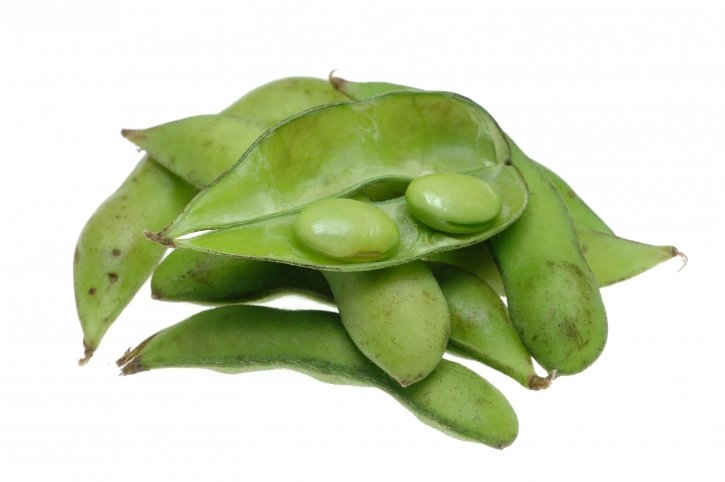Description
Annual herbaceous plant of the Fabaceae or leguminous family, up to 2 m, covered with gray or brown pubescence. It has trifoliate leaves and inflorescences in racemes of up to 8 flowers with white or violet corolla. The fruit is a hairy pod containing 2 to 4 seeds.
The seeds and sprouts of soybeans are dietary elements of great importance in Asian cultures. Oil, lecithin, milk, tofu and various fermented products are obtained from the seeds.
Part used
The seeds are used. The oil is used topically.
Active ingredients
- Lipids (15-20%).
- Phospholipids (major component): phosphatidylcholine (lecithin), phosphatidylethanol amine, phosphatidyl inositol.
- Others: oleic, linoleic, -linolenic, palmitic and stearic acids, vitamin E, sterols (stigmasterol, -sitosterol).
- Proteins (35-50%): glycine, globulin, casein. Essential amino acids.
- Carbohydrates (15-25%).
- Mineral salts: K, Ca, P.
- Phytochemicals: isoflavones.
Three types of extracts are obtained from soybeans:
- Lecithin: consists of phospholipids extracted from soybeans. It is composed of 3-sn-phosphatidylcholine, phosphatidylethanolamine and phosphatidyl-inositol.
- Soybean phospholipids (enriched lecithin): with an average of 76% 3-sn-phosphatidylcholine, up to 7% phosphatidylethanolamine, less than 0.5% phosphatidylinositic acid, 2-6% oil and 0.2-0.5% vitamin E.
- The isoflavonic fraction: mainly composed of genistein, daidzein, glycitein, biochanin A and formononetin, as well as heterosides of the first three: genistin, daidzin and glycitin.
Pharmacological action
* Lecithin:
- Hypocholesterolemic.
- Antiatherogenic.
- Cardiovascular protective.
- Hepatoprotective.
* Isoflavones:
- Improvement of climacteric-related symptoms: sweating, hot flashes, palpitations.
- Cardiovascular protection: improvement of lipid profile, antioxidant, vasodilator and antiplatelet action.
- Prevent osteoporosis: promote bone formation and prevent bone destruction.
The actions of isoflavones are related to several mechanisms
- Interaction with estrogen receptors: isoflavones behave as a selective modulator of estrogen receptors. They show agonist action on β-receptors (located in CNS, bone, kidneys, heart and endothelium, intestinal mucosa and lungs) and antagonist action on α-receptors (located in breast, endometrium, ovary and liver).
- Enzymatic inhibition: aromatase and 5- α reductase (of importance in hormone-dependent cancers), topoisomerase II (apoptosis), tyrosine kinase (inhibition of oncogene expression, inhibition of osteoclast metabolism, inhibition of angiogenesis, vasodilation, inhibition of platelet aggregation, apoptosis etc).
- Others: antioxidant action, modulation of insulin secretion, transformation of estrogens into harmless metabolites.
Indications
* Soy lecithin:
- Hypercholesterolemias and hypertriglyceridemias.
- Prevention of cardiovascular diseases.
- Fatty liver.
- Biliary lithiasis.
- Students.
- Maintenance of cognitive function.
- Skin care.
* Isoflavones:
- For climacteric related disorders: vasomotor symptoms, cardiovascular health, bone care.
Contraindications
* Isoflavones:
- Pregnancy and lactation.
- Hypothyroidism. Isoflavones may decrease levothyroxine absorption.
- History of hormone-dependent cancer.
- Treatment with tamoxifen.
Precautions
Lecithin and isoflavones: in patients with anticoagulant treatment.
Drug interactions
* Lecithin:
* Isoflavones:
- Hormone replacement therapy. Do not associate.
- Anticoagulants and antiplatelet agents.
Side effects
* Lecithin:
- May produce digestive disorders (stomach pain, diarrhea).
* Isoflavones:
- Rarely may produce mild digestive discomfort (nausea, abdominal bloating).
Bibliography
Monografía de la SEFIT (Sociedad Española de Fitoterapia).
Manual de Fitoterapia. Encarna Castillo García e Isabel Martínez Solís. 2ª edición Elsevier.
Abdi F, Alimoradi Z, Haqi P, Mahdizad F. Effects of phytoestrogens on bone mineral density during the menopause transition: a systematic review of randomized, controlled trials. Climacteric. 2016; 19 (6): 535-545.
Beltrán Montalbán E, Navarro Moll MC. El uso de las isoflavonas para el alivio de los síntomas vegetativos de la menopausia: una revisión de las evidencias. Rev. fitoter; 9(2): 101-113, dic. 2009.
Wenzel U, Fuchs D, Daniel H. Protective effects of soy-isoflavones in cardiovascular disease. Identification of molecular targets. Hamostaseologie 2008; 28: 85-88.
Fontvieille A, Dionne IJ, Riesco E. Long-term exercise training and soy isoflavones to improve quality of life and climacteric symptoms. Climacteric. 2017;20(3):233-239.
Moré MI, Freitas U, Rutenberg D. Positive effects of soy lecithin-derived phosphatidylserine plus phosphatidic acid on memory, cognition, daily functioning, and mood in elderly patients with Alzheimer's disease and dementia. Adv Ther. 2014; 31 (12): 1247-62.
